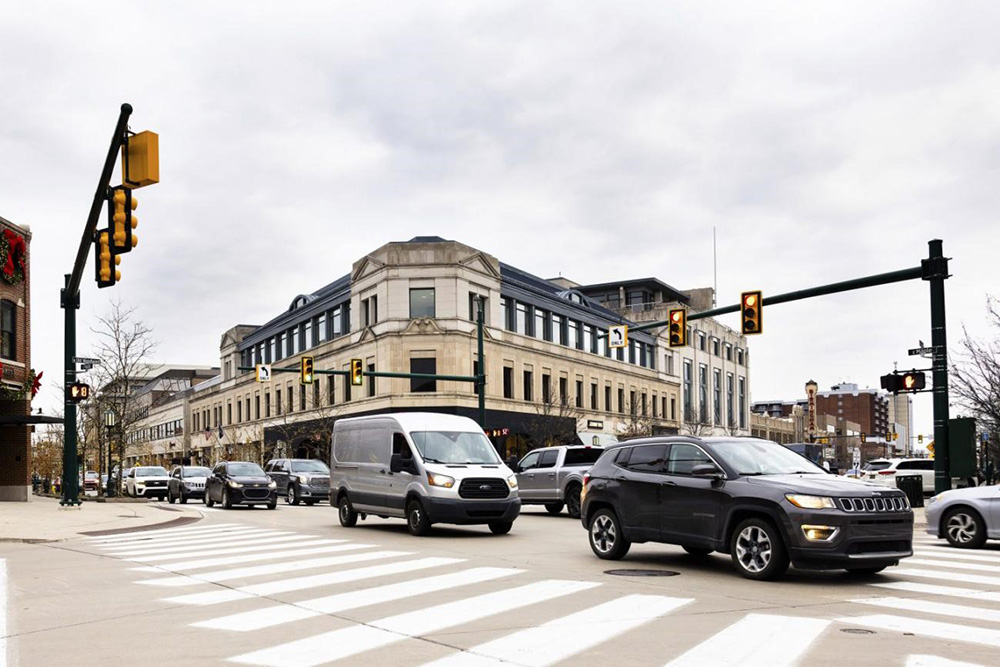
随着汽车和卡车的智能和互联水平越来越高,那些默默无闻、管控交通流量一个多世纪的信号灯或将迎来重大变革。
研究人员正在研究如何使用现代汽车中的各种功能,例如GPS,来提升交通的安全性和效率。最终,这些升级可能会导致当前的红黄绿灯彻底消失,并将控制权交给无人驾驶汽车。
土木工程学教授亨利·刘正通过密歇根大学(University of Michigan)主导这项研究。他表示,新交通信号系统的面世进度可能比人们想象的快得多。
“人工智能的发展速度非常之快,我觉得新信号系统离我们也不远了,” 他说。
多年来,美国的交通信号灯都没怎么变过。历史学家梅根·凯特·纳尔逊在给《史密森尼杂志》(Smithsonian Magazine)的文章中写道,克利夫兰在1914年推出了业界公认的首个“市政交通控制系统”。这个系统由工程师詹姆斯·霍奇发明,使用城市轨道交通供电,分为红、绿两种颜色的信号灯,也就是长期以来铁路系统所使用的颜色。一位警察坐在路边的亭子里,必须通过操作开关来改变信号灯颜色。
数年后,底特律警官威廉·波茨因增加黄灯而受到赞誉。不过,作为该市的公务员,他没法为此申请专利。纳尔逊写道,到了1930年,所有美国主流城市和众多较小的城市至少都安装了一个电交通信号灯。
不过,互联和自动驾驶汽车的发展为信号灯打开了一扇全新的窗户。
工程副教授阿里·哈吉巴巴伊带领的北卡罗莱纳州立大学(North Carolina State University)团队也加入了重构交通流量的阵营。哈吉巴巴伊并没有摒弃当前的交通信号灯,而是建议增加第四个信号灯,例如白色信号灯,这样便可以告诉人们,路上有足够多的自动驾驶汽车,它们可以接管并领路。
哈吉巴巴伊表示:“到十字路口的时候,遵循红灯停,绿灯行的原则,但如果灯变白了,那么跟着前面的车走就行。”他的团队使用了小到可以握持的模型车。
尽管哈吉巴巴伊的研究提出了“白色阶段”这个概念,甚至是增加白灯,但他指出重要的并非是具体颜色。说不定当前的信号灯就够用,例如可以通过对其进行调整,让红灯和绿灯同事闪烁,从而显示无人驾驶汽车正在主导交通。关键之处在于,我们得确保它能像当前的信号灯一样得到广泛采用。
哈吉巴巴伊认为这类做法的实施还需要很长一段时间,因为要实现这一点,道路上自动驾驶车辆的比例必须达到40%-50%。
Waymo发言人桑迪·卡普指出,谷歌(Google)母公司旗下的自动驾驶子公司在洛杉矶和德州奥斯汀推出了完全自动化的顺风车服务,甚至都没有增加第四种交通信号灯。
卡普在发给美联社(The Associated Press)的邮件中写道:“在当前自动驾驶发展的初期阶段,人们创造性地思考如何以稳妥的方式推动安全自动驾驶汽车的部署是一件好事。尽管如此,决策者和基础设施所有者应注意的是,不要急于对具体的自动驾驶汽车项目投资,因为人们最终可能会发现这些投资并不成熟,甚至没有必要性。”
密歇根大学研究人员则持有不同看法。他们在底特律郊区伯明翰开展了一个试点项目,使用来自于通用汽车(General Motors)的速度和定位数据,来调整城市交通灯的时间间隔。这些研究人员最近根据两党基础设施建设法案,拿到了美国交通部的拨款,以测试如何实时调整信号灯。
由于密歇根的汽车研究有驾驶员,并非完全无人驾驶,因此它的可推广性可能要比哈吉巴巴伊的理念高的多。
主导密歇根研究的亨利称,尽管伯明翰街道上仅有6%的汽车与通用汽车系统进行了互联,但它们为调整交通信号灯、疏通交通提供了足够的数据。
之所以选择伯明翰的34个交通信号灯是因为,与全美超过半数的信号灯一样,它们采用的都是固定时间间隔,而且没有任何摄像头或感应器来监控拥堵。亨利称,尽管存在交通监管的高科技解决方案,但城市需要为此进行复杂昂贵的升级。
亨利表示:“这个理念的优点在于,无需对基础设施进行任何调整。数据并不是源自于基础设施,而是来自于汽车制造商。”
密歇根州奥克兰郡道路委员会交通安全主任丹尼尔·德诺称,伯明翰的初步数据仅对绿色信号灯进行了几秒钟的调整,但也足以减少拥堵。这项新的拨款资助研究或将带来更大的改变,它或将实现该县待公布地点交通信号灯的自动化。(财富中文网)
译者:冯丰
审校:夏林
“到十字路口的时候,遵循红灯停,绿灯行的原则,但如果灯变白了,那么跟着前面的车走就行。”
随着汽车和卡车的智能和互联水平越来越高,那些默默无闻、管控交通流量一个多世纪的信号灯或将迎来重大变革。
研究人员正在研究如何使用现代汽车中的各种功能,例如GPS,来提升交通的安全性和效率。最终,这些升级可能会导致当前的红黄绿灯彻底消失,并将控制权交给无人驾驶汽车。
土木工程学教授亨利·刘正通过密歇根大学(University of Michigan)主导这项研究。他表示,新交通信号系统的面世进度可能比人们想象的快得多。
“人工智能的发展速度非常之快,我觉得新信号系统离我们也不远了,” 他说。
多年来,美国的交通信号灯都没怎么变过。历史学家梅根·凯特·纳尔逊在给《史密森尼杂志》(Smithsonian Magazine)的文章中写道,克利夫兰在1914年推出了业界公认的首个“市政交通控制系统”。这个系统由工程师詹姆斯·霍奇发明,使用城市轨道交通供电,分为红、绿两种颜色的信号灯,也就是长期以来铁路系统所使用的颜色。一位警察坐在路边的亭子里,必须通过操作开关来改变信号灯颜色。
数年后,底特律警官威廉·波茨因增加黄灯而受到赞誉。不过,作为该市的公务员,他没法为此申请专利。纳尔逊写道,到了1930年,所有美国主流城市和众多较小的城市至少都安装了一个电交通信号灯。
不过,互联和自动驾驶汽车的发展为信号灯打开了一扇全新的窗户。
工程副教授阿里·哈吉巴巴伊带领的北卡罗莱纳州立大学(North Carolina State University)团队也加入了重构交通流量的阵营。哈吉巴巴伊并没有摒弃当前的交通信号灯,而是建议增加第四个信号灯,例如白色信号灯,这样便可以告诉人们,路上有足够多的自动驾驶汽车,它们可以接管并领路。
哈吉巴巴伊表示:“到十字路口的时候,遵循红灯停,绿灯行的原则,但如果灯变白了,那么跟着前面的车走就行。”他的团队使用了小到可以握持的模型车。
尽管哈吉巴巴伊的研究提出了“白色阶段”这个概念,甚至是增加白灯,但他指出重要的并非是具体颜色。说不定当前的信号灯就够用,例如可以通过对其进行调整,让红灯和绿灯同事闪烁,从而显示无人驾驶汽车正在主导交通。关键之处在于,我们得确保它能像当前的信号灯一样得到广泛采用。
哈吉巴巴伊认为这类做法的实施还需要很长一段时间,因为要实现这一点,道路上自动驾驶车辆的比例必须达到40%-50%。
Waymo发言人桑迪·卡普指出,谷歌(Google)母公司旗下的自动驾驶子公司在洛杉矶和德州奥斯汀推出了完全自动化的顺风车服务,甚至都没有增加第四种交通信号灯。
卡普在发给美联社(The Associated Press)的邮件中写道:“在当前自动驾驶发展的初期阶段,人们创造性地思考如何以稳妥的方式推动安全自动驾驶汽车的部署是一件好事。尽管如此,决策者和基础设施所有者应注意的是,不要急于对具体的自动驾驶汽车项目投资,因为人们最终可能会发现这些投资并不成熟,甚至没有必要性。”
密歇根大学研究人员则持有不同看法。他们在底特律郊区伯明翰开展了一个试点项目,使用来自于通用汽车(General Motors)的速度和定位数据,来调整城市交通灯的时间间隔。这些研究人员最近根据两党基础设施建设法案,拿到了美国交通部的拨款,以测试如何实时调整信号灯。
由于密歇根的汽车研究有驾驶员,并非完全无人驾驶,因此它的可推广性可能要比哈吉巴巴伊的理念高的多。
主导密歇根研究的亨利称,尽管伯明翰街道上仅有6%的汽车与通用汽车系统进行了互联,但它们为调整交通信号灯、疏通交通提供了足够的数据。
之所以选择伯明翰的34个交通信号灯是因为,与全美超过半数的信号灯一样,它们采用的都是固定时间间隔,而且没有任何摄像头或感应器来监控拥堵。亨利称,尽管存在交通监管的高科技解决方案,但城市需要为此进行复杂昂贵的升级。
亨利表示:“这个理念的优点在于,无需对基础设施进行任何调整。数据并不是源自于基础设施,而是来自于汽车制造商。”
密歇根州奥克兰郡道路委员会交通安全主任丹尼尔·德诺称,伯明翰的初步数据仅对绿色信号灯进行了几秒钟的调整,但也足以减少拥堵。这项新的拨款资助研究或将带来更大的改变,它或将实现该县待公布地点交通信号灯的自动化。(财富中文网)
译者:冯丰
审校:夏林
“When we get to the intersection, we stop if it's red and we go if it's green. But if the white light is active, you just follow the vehicle in front of you.”
As cars and trucks get smarter and more connected, the humble lights that have controlled the flow of traffic for more than a century could also be on the cusp of a major transformation.
Researchers are exploring ways to use features in modern cars, such as GPS, to make traffic safer and more efficient. Eventually, the upgrades could do away entirely with the red, yellow and green lights of today, ceding control to driverless cars.
Henry Liu, a civil engineering professor who is leading a study through the University of Michigan, said the rollout of a new traffic signal system could be a lot closer than people realize.
“The pace of artificial intelligence progress is very fast, and I think it’s coming,” he said.
Traffic lights haven’t changed much in the U.S. over the years. Cleveland debuted what is considered the first “municipal traffic control system” in 1914, historian Megan Kate Nelson wrote for Smithsonian Magazine. Powered by the electricity from the city’s trolley line, engineer James Hodge’s invention featured two lights: red and green, the colors long used by railroads. A police officer sitting in a booth on the sidewalk had to flip a switch to change the signal.
A few years later, Detroit police officer William Potts is credited with adding the yellow light, though as a city employee he couldn’t patent it. By 1930, Nelson wrote, all major American cities and many smaller ones had at least one electrical traffic signal.
The advent of connected and automated vehicles, though, has presented a world of new possibilities for traffic signals.
Among those reimagining traffic flows is a team at North Carolina State University led by Ali Hajbabaie, an associate engineering professor. Rather than doing away with today’s traffic signals, Hajbabaie suggests adding a fourth light, perhaps a white one, to indicate when there are enough autonomous vehicles on the road to take charge and lead the way.
“When we get to the intersection, we stop if it’s red and we go if it’s green,” said Hajbabaie, whose team used model cars small enough to hold. “But if the white light is active, you just follow the vehicle in front of you.”
Although Hajbabaie’s research refers to a “white phase” and possibly even a white light, the specific color isn’t important, he said. Current lights could even suffice, say, by modifying them to flash red and green simultaneously to signal that driverless cars are in charge. The key would be making sure that it’s universally adopted like the current signals are.
Using such an approach would be years away, as it would require 40% to 50% of vehicles on the road to be self-driving in order to work, Hajbabaie acknowledged.
Waymo spokesperson Sandy Karp pointed out that the self-driving car subsidiary of Google’s parent company launched a fully autonomous ride-sharing service in Los Angeles and Austin, Texas, even without the addition of a fourth traffic light.
“While it is good at this early stage of AV development that people are thinking creatively about how to facilitate the safe deployment of safe AVs, policymakers and infrastructure owners should be careful about jumping too soon on AV-specific investments that may turn out to be premature or even unnecessary,” Karp said in an email to The Associated Press.
University of Michigan researchers have taken a different approach. They conducted a pilot program in the Detroit suburb of Birmingham using insights from the speed and location data found in General Motors vehicles to alter the timing of that city’s traffic lights. The researchers recently landed a U.S. Department of Transportation grant under the bipartisan infrastructure law to test how to make the changes in real time.
Because the Michigan research deals with vehicles that have drivers, not fully autonomous ones, it could be much closer to wider implementation than what Hajbabaie is seeking.
Liu, who has been leading the Michigan research, said even with as little as 6% of the vehicles on Birmingham’s streets connected to the GM system, they provide enough data to adjust the timing of the traffic lights to smooth the flow.
The 34 traffic signals in Birmingham were chosen because, like more than half of the signals nationwide, they’re set to a fixed-time schedule without any cameras or sensors to monitor congestion. Liu said although there are higher-tech solutions to monitoring traffic, they require cities to make complex and expensive upgrades.
“The beauty of this is you don’t have to do anything to the infrastructure,” Liu said. “The data is not coming from the infrastructure. It’s coming from the car companies.”
Danielle Deneau, director of traffic safety at the Road Commission in Oakland County, Michigan, said the initial data in Birmingham only adjusted the timing of green lights by a few seconds, but it was still enough to reduce congestion. Even bigger changes could be in store under the new grant-funded research, which would automate the traffic lights in a yet-to-be announced location in the county.






